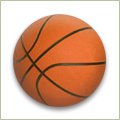 AP Photo/David Zalubowski
AP Photo/David ZalubowskiBest wishes for a quick recovery to Denver Nuggets' star Carmelo Anthony, who suffered a non-displaced third metacarpal fracture in his right hand in the 3rd quarter of last night's game against the Indiana Pacers.
As reported by ESPN.COM , Anthony sustained the injury to his shooting hand when the Pacers' Jeff Foster slapped down on him as he was going up for a shot.
While they don't occur as often as ankle sprains and knee injuries, hand and finger injuries are not uncommon in a ball-sport like basketball.
Most people who play often enough will eventually have a jammed finger, mallet finger, dislocation, or fracture. Wrist injuries are also commonly seen and fractures of the scaphoid bone are often missed because someone assumes it's a (more commonly seen) wrist sprain.
Chris Mullin, the former St Johns and Golden State Warriors shooter supreme, went through 3 hand surgeries during his career. Although, they were to his right (non-shooting) hand, he once said, "Saying it's OK because the injury is to the non-shooting hand is like saying it's OK to have an injury to your non-walking foot".
So what will likely happen to Melo?
- He'll get a splint to support his wrist and hand while he heals.
- He may get some electrical stimulation or hyperbaric oxygen treatments to help with bone healing.
- He'll keep working out to maintain his cardiovascular fitness and strength.
- As time goes by, he'll get some occupational therapy to work on regaining strength and flexibility in his right hand.
- He can work on his left hand skill more.
- Once cleared to return to practice, it will probably take some time to get his shot back and regain his confidence that he can take some bumps and bruises without the injury recurring.
He's demonstrated his toughness in the past. Here's hoping that he'll come back and play well with the hand he's been dealt (sorry).








